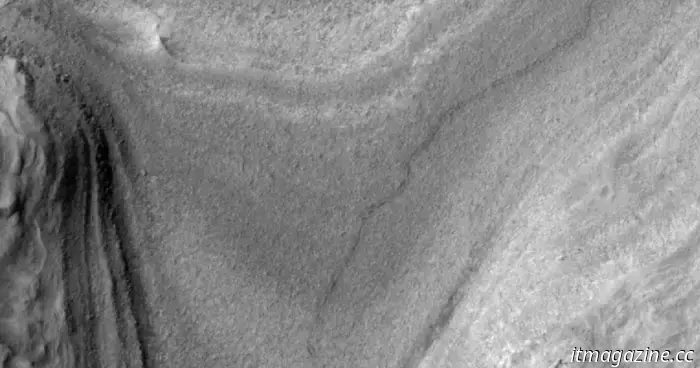
NASA has obtained an impressive aerial photograph of Curiosity traversing the surface of Mars.
NASA/JPL-Caltech/University of Arizona
NASA's Mars Reconnaissance Orbiter (MRO) has captured what is thought to be the first orbital photograph of the Curiosity rover while it is in motion.
The stunning image, enhanced for clarity, distinctly displays the tracks left by Curiosity's six wheels as it traverses the arid terrain of the red planet, with a small dot marking the rover's position.
Those tracks? That’s @MarsCuriosity on the move. This image was taken by the Mars Reconnaissance Orbiter, which has spent the last twenty years searching for evidence of ancient water on Mars from its orbit. Meanwhile, Curiosity has been digging for answers since 2012. pic.twitter.com/8ioEXBvR8R — NASA JPL (@NASAJPL) April 24, 2025
“NASA's Curiosity Mars rover has never shied away from the camera, appearing in selfies and images captured from space. However, on February 28, Curiosity was photographed in what is believed to be the first orbital image of the rover mid-drive on the red planet,” said NASA’s Jet Propulsion Laboratory (JPL), which manages the Curiosity mission.
The image was taken by the MRO’s HiRISE (High-Resolution Imaging Science Experiment) camera, with the tracks measuring approximately 1,050 feet (320 meters) long. Curiosity is depicted near the base of a steep slope that, according to JPL, the rover has since ascended. Since its arrival on Mars in 2012, the rover operates using a combination of remote commands from Earth and onboard autonomy, with JPL engineers coordinating with scientists to plan each day’s itinerary.
NASA noted that the tracks will likely remain visible “for months” before being erased by Martian winds.
“They represent around 11 drives starting on February 2, as Curiosity moved at a maximum speed of 0.1 mph (0.16 kph) from Gediz Vallis channel on its way to the next scientific destination,” JPL explained.
The rover has been focused on studying whether Mars ever had conditions conducive to microbial life. It is also gathering data concerning the planet’s climate and geology while analyzing the environment in preparation for upcoming crewed missions.
The MRO orbits Mars at altitudes between approximately 155 to 196 miles (250 to 315 kilometers), with its main goals being to investigate Mars’ geology and climate, look for signs of water, and assist other Mars missions by relaying data and scouting potential landing sites for future missions.
Curiosity is not the only NASA rover exploring the Martian surface. The more advanced Perseverance rover has been active on the red planet since its dramatic landing, which was captured on high-resolution video, in 2021.
On a clear night, Mars can be seen until November. So, the next time you spot it, take a moment to reflect on the fact that on that distant planet, NASA has two rovers navigating the surface, conducting scientific research conceived by humans right here on Earth.
Not too long ago, Trevor relocated from one tea-loving island nation that drives on the left (Britain) to another (Japan)…
Revisit the Mars rover’s ‘7 minutes of terror’ during its landing 12 years ago
At 1:31 a.m. ET on August 6, 2012, NASA’s Curiosity rover made an impressive landing on Mars's surface. To commemorate the 12th anniversary, NASA released a video featuring members of the Curiosity team discussing how they accomplished this noteworthy achievement, particularly focusing on the so-called “seven minutes of terror” during the final descent.
NASA’s Mars Odyssey Orbiter recently reached a significant milestone
NASA's Mars Odyssey Orbiter is among seven spacecraft currently orbiting the red planet (three of which are operated by NASA), capturing images and conducting tasks from a distance to help scientists learn more about the fourth planet from the sun.
NASA halts communication with its Mars robots, but they haven't lost touch
NASA's Mars robots take commands from the mission team at the Jet Propulsion Laboratory in Southern California, but communication will be paused for the next few weeks. This is due to the immense fireball in the sky – known as the sun – positioning itself between Earth and Mars. This celestial occurrence is referred to as solar conjunction and happens every couple of years.





Other articles
 Google has confirmed that Gemini AI will be integrated into cars, wearables, and other devices this year.
It has been officially verified that Gemini will be available on Android Auto, wearables, and additional platforms.
Google has confirmed that Gemini AI will be integrated into cars, wearables, and other devices this year.
It has been officially verified that Gemini will be available on Android Auto, wearables, and additional platforms.
.jpg) 3 excellent free films to watch this weekend (April 25-27)
Watch these free movies from April 25-27: a crime epic by Martin Scorsese, a timeless buddy comedy, and a science fiction monster flick.
3 excellent free films to watch this weekend (April 25-27)
Watch these free movies from April 25-27: a crime epic by Martin Scorsese, a timeless buddy comedy, and a science fiction monster flick.
 Google Gemini ranks among the top three AI services, boasting 350 million monthly users.
Although there has been substantial growth, Google's Gemini chatbot seems to trail behind competitors such as OpenAI's ChatGPT and Meta AI regarding the number of monthly active users.
Google Gemini ranks among the top three AI services, boasting 350 million monthly users.
Although there has been substantial growth, Google's Gemini chatbot seems to trail behind competitors such as OpenAI's ChatGPT and Meta AI regarding the number of monthly active users.
.jpg) Three overlooked Netflix films to check out this weekend (April 25–27)
Looking for hidden gems? Netflix offers numerous underrated films, featuring a historical drama, a touching international selection, and a distinct sports movie.
Three overlooked Netflix films to check out this weekend (April 25–27)
Looking for hidden gems? Netflix offers numerous underrated films, featuring a historical drama, a touching international selection, and a distinct sports movie.
.jpg) Three excellent Hulu movies to watch this weekend (April 25 – 27)
Jennifer Lawrence's return in comedy is one of the three must-see Hulu films this weekend.
Three excellent Hulu movies to watch this weekend (April 25 – 27)
Jennifer Lawrence's return in comedy is one of the three must-see Hulu films this weekend.
 Samsung has just revealed the 'official' pricing and storage options for the Galaxy S25 Edge.
Samsung inadvertently disclosed the price of its forthcoming slim and lightweight phone, the Galaxy S25 Edge.
Samsung has just revealed the 'official' pricing and storage options for the Galaxy S25 Edge.
Samsung inadvertently disclosed the price of its forthcoming slim and lightweight phone, the Galaxy S25 Edge.
NASA has obtained an impressive aerial photograph of Curiosity traversing the surface of Mars.
A NASA orbiter has taken an impressive photo of the Curiosity rover on Mars' surface.
